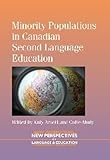Minority Populations in Canadian Second Language Education / ed. by Katy Arnett, Callie Mady.
Material type: TextSeries: New Perspectives on Language and EducationPublisher: Bristol ; Blue Ridge Summit : Multilingual Matters, [2013]Copyright date: ©2013Description: 1 online resource (224 p.)Content type:
TextSeries: New Perspectives on Language and EducationPublisher: Bristol ; Blue Ridge Summit : Multilingual Matters, [2013]Copyright date: ©2013Description: 1 online resource (224 p.)Content type: - 9781783090303
- 9781783090310
- Education, Bilingual -- Canada
- Education, Bilinguial -- Canada
- Language and languages -- Study and teaching -- Canada
- Linguistic minorities -- Canada
- Multicultural education -- Canada
- Second language acquisition -- Study and teaching -- Canada
- LANGUAGE ARTS & DISCIPLINES / Study & Teaching
- Canada
- additional language learning
- language maintenance
- language revitalization
- minority languages
- plurilingualism
- second language education
- 418.0071/071 23
- P57.C3 M56 2013
- P57.C3 M56 2013
- online - DeGruyter
| Item type | Current library | Call number | URL | Status | Notes | Barcode | |
|---|---|---|---|---|---|---|---|
 eBook
eBook
|
Biblioteca "Angelicum" Pont. Univ. S.Tommaso d'Aquino Nuvola online | online - DeGruyter (Browse shelf(Opens below)) | Online access | Not for loan (Accesso limitato) | Accesso per gli utenti autorizzati / Access for authorized users | (dgr)9781783090310 |
Frontmatter -- Contents -- Contributors -- Introduction: Broadening the Lens of Second Language Education in Canada: Minority Populations in Canadian Second Language Education -- Part 1: French as an Additional Language: Immigrants’ Learning of French in English-dominant Canada -- 1. Adding Languages, Adding Benefits: Immigrant Students’ Attitudes Toward and Performance in FSOL Programs in Canada -- 2. Learning French in British Columbia: English as Additional Language Learner and Parent Perspectives -- 3. French is Hard: An English Language Learner’s Experience in Core French -- Part 2: Heritage Language and Culture Maintenance for Immigrants and Their Families -- 4. Fostering Heritage Languages and Diasporic Identities: The Role of Grassroots Initiatives in Alberta and British Columbia -- 5. Self, Identity and Motivation in the Development and Maintenance of German as a Heritage Language -- 6. Learning Chinese as a Heritage Language -- Part 3: Individuals with Disabilities and Second Language Study -- 7. The Genesis and Perpetuation of Exemptions and Transfers from French Second Language Programs for Students with Diverse Learning Needs: A Preliminary Examination and Their Link -- 8. Reading Without Borders: At-Risk Students Transitioning from L1 to L2 in French Immersion -- 9. The Writing Processes of a Grade 7 French Immersion Student with Asperger Syndrome -- Part 4: The Revival, Maintenance and Growth of Aboriginal Languages in Canada -- 10. A Fair Country? Consideration of Canada’s Debt to Indigenous Language Renewal -- 11. First Nations, Métis and Inuit K-12 Language Programming: What Works? -- 12. How Have Aboriginal North Americans Responded to Writing Systems in Their Own Languages? -- Conclusion: Additional Conceptions of Second Language Education in Canada -- Index
restricted access online access with authorization star
http://purl.org/coar/access_right/c_16ec
Until now, the picture painted of French second language learning in Canada has tended to focus on successful French immersion. This volume offers a broader representation, in response to the demographic changes that have made the French language classroom a more complex place. Focusing on inclusion and language maintenance, the chapters discuss how a multilingual population can add the two official languages to their repertoire whilst maintaining their languages of origin/heritage; how the revitalization of Indigenous languages can best be supported in the language classroom, and how students with disabilities can be helped to successfully learn languages.
Mode of access: Internet via World Wide Web.
In English.
Description based on online resource; title from PDF title page (publisher's Web site, viewed 01. Dez 2022)


